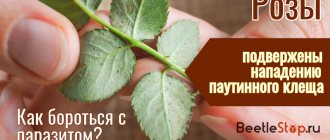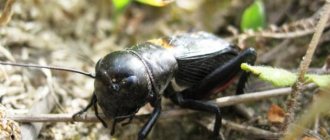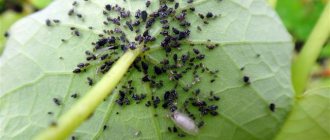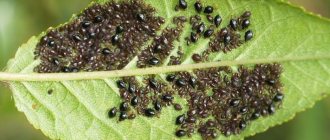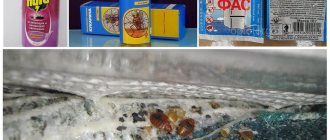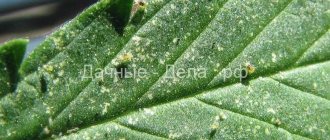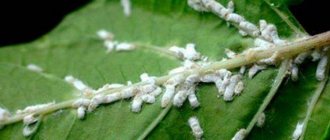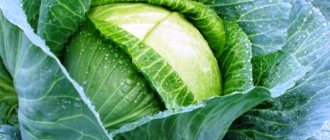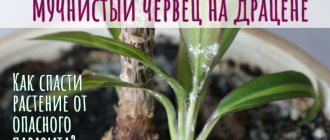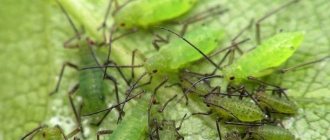Where do aphids come from in an apartment? Prolific and voracious pests are capable of destroying all indoor plants in a short time. By sucking juice from leaves and shoots, they inhibit the development of flowers, which leads to their death. The greatest damage is caused to flowering plants. A female aphid hatches up to 100 individuals. How to get rid of aphids on indoor flowers at home?
- Reasons for appearance
- Species found on Black Aphid flowers
- White aphid
- Beet aphid
- Kalanchoe
- Fitoverm
What harm can aphids cause to indoor flowers?
Aphids on indoor plants are a common occurrence. The main danger of insect activity is the destruction of vegetation. Aphids pierce the skin of the leaves and suck out the juice. Colonies of parasites attack young and adult plants.
Single individuals lead to the drying out of several leaves of the flower; with timely help, the plant can be saved. A large accumulation of aphids on one indoor plant leads to its death.
Sources and signs of infection
Often aphids enter the house on the clothes and shoes of residents when they return from the garden or dacha. Another option is with purchased flowers, from where insects can easily move onto any vegetation that is in the room. After purchasing a home flower or shrub, it is recommended to quarantine it, and before that you need to do the following:
- rinse the entire plant;
- disinfect the container;
- change the soil.
Adult flying insects enter the room through windows, vents and doors, and then find indoor flowers and lay eggs on them.
After some time, the owners have to be perplexed, because whole colonies of sucking pests suddenly appear on the leaves.
In the summer, aphids crawl into flower pots placed in the yard, terrace or veranda. In a few days, the colony can cover the entire plant. Ants often become carriers of aphids. They eat honeydew, which is secreted by sucking insects, and then the aphids stick to the body of the ants along with the sweet liquid and end up on other flowers.
It is enough to examine an indoor flower or shrub to understand that it is infested with pests. Aphids are clearly visible, and before they appear, oblong eggs can be seen on the underside of the leaves, especially between the petioles. They are usually located in groups of several. But there are species of aphids in which the young generation is not hatched from eggs, but is born as fully formed insects. If there is no masonry, you need to carefully examine the flower. The following signs should alert you:
- leaf blades, petioles and shoots are covered with traces of a waxy liquid - honeydew;
- the buds do not open, wither and fall off;
- the leaves become stained, curl, turn yellow and fall off.
The sticky liquid secreted by aphids is similar to that produced by other pests, for example, whitefly larvae, scale insects, thrips, and mealybugs. To choose the right treatment method, you need to evaluate the condition of the flower comprehensively, and not based on one symptom, and you will also have to remember what events preceded the disease. For example, before this, the owners of the house went to the country, bought a new plant, had windows open for a long time, etc.
Signs of pest damage
It is easy to see the presence of aphids on a plant - upon inspection, syrupy traces appearing from pest secretions and other symptoms are visible on the foliage.
Read more about why aphids appear on plants in the article here.
The first signs of aphid infestation:
- The shoots curl and wither. Young specimens of domestic flowers suffer.
- The presence of black marks on the leaves. Aphids spread sooty fungus, which appears as dark spots.
- Clusters of insects are noticeable on the underside of the leaves.
- Opened flower buds look ugly.
- Some flowers do not open.
There are several types of parasites. At the same time, the methods of combating it depend on the type of aphid. At the first signs of damage, it is necessary to immediately get rid of aphids. To do this, you need to choose the appropriate method and take preventive measures.
White
Dicotyledonous plants are most susceptible to attack by white aphids. Parasites are rare on domestic flowers. Aphids, covered with white pollen, penetrate the root system and suck out the juice. The plant dies.
Green
The parasite has a pale green color. Settles on bushes and trees. Dangerous for decorative Chinese roses, lemons, etc. Before winter, the female lays eggs near the buds. In the spring, the larvae hatch and parasitize the plant.
Black
Black aphids are dark in color and their body length reaches 5 mm. To pierce the foliage, a proboscis is located on the body of the parasite, with the help of which the insect drinks juice. Black aphids reproduce at a high rate because they do not need to mate. The larvae appear on young shoots of indoor plants and eventually move to adult specimens of vegetation.
Yellow
The yellow aphid has a corresponding color. Prefers to settle on coniferous vegetation near the buds. The primitive parasite does not spread to neighboring plants. One generation is hatched per year. Therefore, yellow aphids are few in number.
Effective methods of controlling aphids on coniferous trees
Bloody
The blood aphid is native to America. In its homeland, the insect parasitizes in the bark of elm trees. On the territory of Russia, the insect is found in gardens, rarely on domestic vegetation. The body of the parasite is covered with wool-like waxy threads.
Types of aphids on flowers, distinctive features and breeding features
Aphids on indoor flowers can be different. Each species has characteristic features and regions of distribution. The methods of struggle do not differ from each other.
Green peach or greenhouse
The green peach aphid has several names. It is also called greenhouse or tobacco.
The following features are characteristic of this type of pest:
| Index | Description |
| Color | The body of the female aphid is yellow, pink or green. The tail is yellow, the abdomen is green, the chest and antennae are black. The female lays black eggs. |
| Size | The female's body can reach up to 3 m in length. Juice tubes, expanded at the base, reach a length of about 1 mm. The tail is 1/3 the size of the juice tubes. The tail can reach up to 0.5 mm. |
| What plants does it affect? | The green peach aphid causes the greatest harm to garden plants. Its primary hosts are cherry, apple, plum, apricot and peach trees. Then the pest moves on to potatoes, nightshades, carrots, watermelon and tobacco. The number of secondary hosts includes more than 200 crops. Susceptible indoor plants include kalanchoe, lemon, orchid, rose, violets, hydrangea and basil. In rare cases, aphids “settle” on flowers that secrete a poisonous milky sap. These include ficus and spurge. |
| Regions of distribution | The green peach aphid is widespread in European countries, Asia, America and Africa. The insect has become slightly widespread in the western part of Russia, in the Far East. Isolated cases are also observed in Ukraine, the Caucasus, Transcaucasia and Moldova. |
Green peach aphid is a dangerous pest, which is considered to be native to Asian countries. The reason for this opinion is that the peach tree (the host plant of aphids) is native to Asia.
Melon or cotton
Aphids on indoor flowers, which must be combated immediately after detection, can be of several types.
The danger of melon aphids is the possibility of infecting plants with a dangerous virus.
Among the distinctive features of cotton aphids are:
- long mustache. In size - larger than that of individuals without wings;
- the tail and juice tubes are small and short;
- dark green tail, black head and chest.
The cotton aphid has become widespread in Russia, Asian countries, Europe and America. Because
The melon aphid has a narrow oval body. It can reach up to 2.1 mm in length. It has a straight forehead and antennae, the size of which can reach up to ½ hour of the body. There are hairs all over the surface of the body that are difficult to see with the naked eye.
330 plant species are affected by melon aphids. The pest is a carrier of about 50 viral diseases, but causes the greatest harm to agricultural crops.
Bean (beet)
Beet aphids have several names. It is also called leaf or legume. This species poses a danger to beets.
The wingless aphid has an ovoid body, the length of which can reach up to 2.5 mm. The body is greenish-brown or black. On the surface you can see traces of a waxy coating. Paws and
The distribution area is very wide. In Russia, beet aphids can be found in the North-West, Siberia, Altai, and central regions. Aphids are also found in Asia, Kazakhstan, and Moldova.
Big potato
The potato aphid is the largest representative. Insects can reach up to 3.5 m. In this case, potato aphids, in most cases, live in large colonies. Both winged and wingless individuals live in the colony. Representatives with wings are able to move between plants, which harms both agricultural crops and indoor flowers.
The color feature of potato aphids is the variety of pigmentation. On one plant you can find individuals of the same species with different colors (brownish head, dark colored body). Wingless females are green in color and have an elongated body.
The danger of potato aphids lies in its widespread distribution. In Russia, the pest is widespread.
How do aphids get into the house?
The most common type of aphid found on indoor plants is the aphid. Pests are located on the roots, leaves, stems and flowers of indoor plants.
Where and why do pests appear within the apartment:
- Purchase of an infected plant.
- Migration of parasites from the street on clothing or household items.
- Aphids enter from the street through open windows.
- Sticking of insects when airing flowers outdoors.
- The vital activity of ants, for which aphids are the main source of food.
Pests practically do not move around the plant. Aphids are found everywhere on domestic flowers, regardless of the part of the crop. First, young shoots are affected, then the parasite moves to denser and stronger areas. The leaves and stems turn yellow and curl into a tube. Aphids are visible to the naked eye.
A warm and dry climate promotes active reproduction of aphids. The infected flower must be quarantined so that other crops do not become targets of aphid attack.
Where do white aphids come from on indoor and garden plants and how to fight them? Photo of the pest
Aphids are a representative of the class Hemiptera.
The insect attacks indoor flowers by drinking juice from them. Plants weaken, dry out and die. Pests can choose roots, flowers, leaves, stems. They prefer soft stems that are easier to pierce.
The article describes in detail what the pest looks like and why it appears, what it threatens plants with, as well as how to get rid of such a scourge and what preventive measures to take to protect yourself in the future.
Effective chemicals
Among the products that effectively fight parasites on indoor flowers, several chemical preparations can be noted - “Fitoverm”, “Aktellik”, “Iskra”, “Tanrek”, “Aktara”. The use of pesticides allows you to get rid of aphids on indoor plants in a short time. Treatment consists of spraying the crop. The main thing is to follow the dosage indicated in the instructions for use.
"Fitoverm"
The drug "Fitoverm" is of biological origin. Pests do not get used to the product. Therefore, treatment can be carried out until the insects are completely destroyed. It is recommended to take a week break between spraying. Dilution of the drug is carried out strictly according to the instructions.
"Aktellik"
The drug "Actellik" copes effectively with the task. The pesticide causes poisoning of parasites and their death. The toxic substance is dangerous for pets and children. Therefore, processing must be carried out outdoors.
When using the product indoors, the air temperature in the house should not exceed +15°C.
"Spark"
Several drugs are produced under the Iskra brand in different forms. To kill aphids, you can choose any type of product. The pesticide is considered moderately hazardous. Can be applied indoors and outdoors.
"Tanrek"
The insecticide is an effective product that is used to protect berries, fruits, vegetables and domestic crops. "Tanrek" is a domestic drug, available in bottles with different dosages (10, 50 and 100 ml). The main active ingredient is imidacloprid. It penetrates the structure of the plant, entering the parasite's body along with the juice. The death of aphids occurs within 24 hours.
"Aktara"
You can fight aphids on indoor plants at home using the drug "Aktara". The substance penetrates into the juice of flowers, causing poisoning of parasites. The action begins within a day. On larger plants, it takes longer to activate the product - up to two days. Aphids get used to the drug, so Aktar needs to be alternated with other pesticides.
The main signs of aphids
In order to quickly get rid of aphids, you need to detect them as quickly as possible and immediately begin to fight them. To do this, it is recommended to systematically inspect your home plants. If you are lucky enough to find aphids when there are still very few of them, then all you need to do to get rid of them is to crush the adults, as well as all the larvae. If possible, cut and destroy the affected parts of the bush. But in the case when there are a lot of pests on the plant, more effective methods will be needed to get rid of them. There are several signs by which you can understand that there are aphids on a flower:
- The plant becomes less attractive and looks sickly.
- On the surface of the above-ground part of the bush you can find very small punctures that aphids leave during their life processes.
- The surface of the stems and foliage becomes sticky from the honeydew, their color gradually changes to black, they curl up and dry out.
- The open buds become smaller and deformed; they quickly fade and fly off.
- Near the affected plant you can find ants who are trying to get their favorite treat.
Aphids can greatly harm any home flower. This pest is considered one of the main carriers of viral and fungal diseases. For example, in those areas where honeydew appears, sooty fungus forms. Aphids pose the greatest danger to indoor crops such as orchids, roses, fuchsias, hyacinths, palmaceae, hibiscus, chrysanthemums, spathiphyllums and cyclamens.
As soon as aphids are found on the plant, it should be moved away from other flowers so that the pests cannot settle in them. After this, you can begin to fight insects.
Folk methods of struggle
It’s easy to quickly get rid of aphids with your own hands. This does not require the use of poisons that are dangerous to household members. There are many safe, effective folk methods. They can be used regardless of the reasons for the appearance of aphids. Among them there are infusions, decoctions and other effective remedies.
Ammonia
Ammonia is often used in pest control. Ammonia can also help control aphids on indoor plants. To prepare the working solution you need:
- Boil 500 ml of water.
- Add 1-2 tsp. grated laundry soap.
- Dissolve the grains.
- Cool the liquid.
- Pour in 2 tsp. ammonia.
- Mix.
The prepared solution must be sprayed onto the foliage from the top. Treat the bottom with a cotton swab dipped in liquid. After spraying, you need to wait 20–25 minutes and wash off the alcohol composition from the foliage with water. This will avoid the formation of a burn.
Red pepper
Aphids are afraid of some spices. You can effectively cope with parasites using red pepper. To prepare you need:
- Heat water – 200 ml.
- Add 25 g pepper (ground).
- Boil.
- Leave to infuse for 24 hours.
- Strain the solution.
- Add 1 tsp. soap
- Treat the foliage on both sides with the resulting mixture.
Vinegar
When fighting aphids, table vinegar is often used. It causes paralysis of insects and quickly destroys pests. The processing looks like this:
- Dissolve 1 tbsp in a liter of water. l. vinegar.
- Wipe or spray the indoor flower, avoiding any liquid getting on the flowering buds.
- If necessary, repeat the procedure.
Soda and salt
An indispensable tool in the fight against aphids is salt and soda. These components can be combined or used separately. There are several options for preparing the working solution. Treatment is carried out by spraying or wiping the foliage.
First option:
- Boil a liter of water.
- Add 2 tbsp. l. salt.
- Dissolve, cool.
Second option:
- Heat 500 ml of water.
- Add 1 tbsp. l. soda
- Mix.
Third option:
- Boil a liter of water.
- Add according to Art. l. soda and salt.
- Mix.
To enhance effectiveness, add 1 tsp to the solution. vinegar per liter of liquid.
Tar soap
Tar soap can be used to control aphids and other pests. It is easy to prepare a mixture for treating plants:
- Grate ¼ piece of soap on a fine grater.
- Boil a liter of water.
- Add soap and mix thoroughly.
The resulting liquid can be used to treat deciduous and coniferous home crops. The procedure must be carried out at intervals of 5–7 days. After each spraying, the composition must be washed off the plant, leaving it on for 30 minutes. In this case, the soap substance is not allowed to get into the ground.
Cinnamon
Cinnamon is a popular spice. The powder can be used in its pure form, sprinkled on the soil in the pot. You can prepare a decoction or infusion. For the decoction you need:
- Pour 1 tbsp. l. cinnamon (you can take a whole spice pod) 500 ml of water.
- Boil for 20 minutes.
- Cool.
- Use as a spray.
Preparation of the infusion:
- 1 tsp. ground cinnamon pour 200 ml of vodka.
- Leave in a dark place for 24 hours.
- Dilute the composition with water in a 1:1 ratio.
- Treat the plants.
- Wash off the substance after 20 minutes. After application.
Ash
Tree resin has long been used to combat parasites. To destroy aphids you need:
- Dissolve 200 g of ash in 5 liters of water.
- Add 5 tbsp. l. soap
- Let it brew for 48 hours.
Milk and iodine
A mixture of iodine and milk is used to kill aphids, slugs and other parasites. The working staff is prepared from two main components:
- A liter of milk or kefir.
- Five drops of iodine.
- Mix.
- Treat the plant.
- After 2–3 hours, remove the mixture from the foliage with a damp cloth.
"Coca Cola"
A tasty carbonated drink quickly deals with various pests, causing food poisoning. The use of Coca-Cola is allowed on adult non-flowering plants. To kill aphids you need to spray the flower.
Celandine
To use, you will need dry celandine grass or a fresh bush. To prepare the product you need:
- Boil 500 ml of water.
- Pour liquid into a glass of celandine.
- Let it brew for a day.
Garlic
Garlic has a detrimental effect on many parasites. To kill aphids you will need an aqueous solution of the root vegetable:
- Pass the head of garlic through a press.
- Pour 500 ml of boiling water.
- Place in a dark place for a day.
- Strain.
To destroy large colonies of aphids, an undiluted solution is used, which must subsequently be washed off the plant.
Mustard
Mustard powder is used to control aphids. To prepare the product you need:
- Dissolve 10–15 g of mustard in a liter of warm water.
- Leave for 3–5 hours.
- Strain.
Vodka
Vodka is often used to prepare infusions. It does not need to be diluted with water, since the amount of alcohol is not dangerous for the plant. It is enough to spray an indoor flower on all sides with 40° vodka at intervals of 3 days. After this, the aphids on the foliage will die.
We fight aphids by spraying with vodka - Effective recipes
Green soap
An effective remedy that helps kill aphids is green soap. The composition includes potassium salt, vegetable oil and fats, water. After applying the substance to the plant, part of the solution gets onto the body of the insect. The pest is unable to breathe and dies.
Birch tar
Birch tar is a viscous, greasy substance. It does not dissolve in water, so the first preparation of a working composition for treating plants against aphids can cause difficulties. Before you start using the product, you should familiarize yourself with the rules for preparing the solution:
- Mix 10 ml of birch tar (can be bought at a pharmacy) with 50 ml of liquid soap or shampoo.
- Leave for 1.5 hours to better combine the components.
- Pour the composition into 10 liters of water.
- Mix.
The resulting liquid can be wiped and sprayed on plants. Aphids die upon contact with a soap solution within two to seven hours. Using tar in its pure form is dangerous. It can burn leaves.
Tobacco
Tobacco tincture is used to combat aphids, powdery mildew and other pathologies. To prepare the recipe you need:
- Pour 50 g of dry tobacco into a liter of boiling water.
- Leave for 24 hours.
- Strain.
- Use by spraying.
Boric acid
Boric acid must be used to wipe the leaves infected with aphids. It is convenient to use a cotton pad or a piece of gauze. Coniferous plants can be sprayed with a solution of the product with water. To do this, mix part of the acid with half of the water.
Pest control on orchids
The insect is easy to detect by its white coating . It is necessary to check hidden places - the bases of shoots, buds, the underside of leaves.
Most often, aphids appear on orchids in a dehydrated room. Humidity should be maintained above 60%.
- You should regularly spray the leaves and stem with cool water, avoiding the accumulation of liquid in the flower, and fertilize the plant in a timely manner.
- An infected orchid must be immediately isolated from other indoor flowers, since aphids spread quickly.
- The simplest method of control is to thoroughly wash the flower and remove damaged parts.
The action of a soap solution is antiseptic for the plant and destructive for parasites.- Citrus infusion also helps fight the spread of aphids. To prepare it, you need to mix 100 g of lemon, orange or tangerine peels with a liter of boiling water and leave for three days. For greater effect, you can place the soaked peels on the ground. reacts poorly to essential oils. Suitable oils for treating orchids include tea tree oil, peppermint oil and neem oil. 30 drops of oil should be dissolved in 500 ml of water and applied to the plant with a sponge.
Additional tips and tricks
Fighting aphids is a simple process. But the procedure for exterminating pests must follow certain rules:
- Maximum effectiveness can only be achieved by treating all infected areas of the plant. Therefore, it is necessary to thoroughly wipe and spray the foliage, stems and root part of the indoor crop.
- It is better to alternate aphid repellents. This will prevent pests from becoming accustomed to the active component.
- The use of oil solutions is allowed only on the green part of the vegetation. Contact of the product with the buds is prohibited.
- It is necessary to spray flowers in the evening or early in the morning. The room should be damp and cool.
- To enhance the impact of folk remedies, the use of a plastic bag is allowed. After treating the plant with the selected solution, put a bag on it and leave it for several hours.
Aphids on indoor flowers are a common problem for indoor plant lovers. To prevent parasites from destroying crops, they must be removed in a timely manner. Regular examination of flowers will allow you not to miss important time. When the first symptoms are detected, you must immediately take measures to eliminate the insects.
Reasons for appearance
You can determine that there are aphids on indoor flowers by several signs:
- leaf curling;
- puncture marks;
- small insects with round or elongated bodies;
- growths on soft stems;
- deformed flowers;
- sticky, sweet film;
- black coating.
The color of the pest is predominantly light green and white. Flowers with delicate leaves are destroyed first. Instead of a mouth opening, the aphid has a long or short proboscis, with which it pierces the leaf cover to suck out plant sap.
The appearance of aphids is due to several reasons:
- Purchasing a flower plant with eggs of the pest, from which it spread to other house plants.
- Infection through soil during transplantation, if it has not been disinfected.
- Insemination by a winged individual during ventilation on the balcony of a house, near an open window.
- The larvae are brought into the house with soil on the fur, paws of dogs and cats.
- Purchasing bouquets of chrysanthemums or roses infected with aphids.
- The appearance of ants in the room, contributing to the formation of insect colonies.
Insects multiply exponentially every 10 days, which weakens indoor flowers or leads to death.
Danger of sucking pest
When settling on a plant, aphids suck the juices out of it, and because of this, the flower gradually withers. Sick specimens look as if they are simultaneously lacking moisture, light and nutrition. If they are not cured in time, the shoots and main stems become bent, all parts of the plant become deformed, and then dry out. Sick specimens look more ugly than beautiful.
Sticky honeydew is a favorable environment for sooty fungus, which is the causative agent of dangerous infectious diseases. A weakened plant is less resistant to pathogens of all types. Having noticed white aphids on indoor plants, you need to fight them immediately - this pest by itself will not go away. Crops for which sucking insects are most dangerous:
- zygocactus (“Decembrist”);
- chrysanthemums;
- begonia;
- common primrose;
- large leaf hydrangea;
- calla (calla lily);
- Persian and European cyclamens;
- Saintpaulia;
- pelargonium (geranium).
